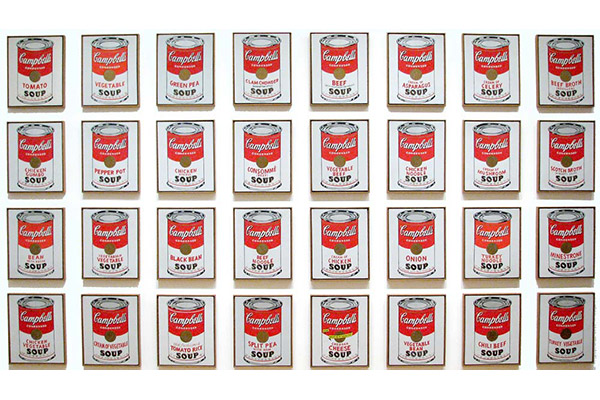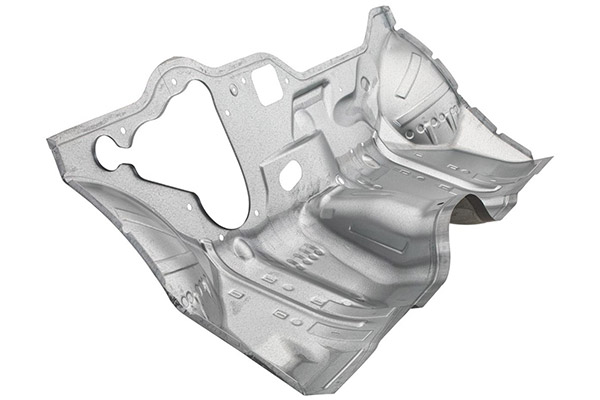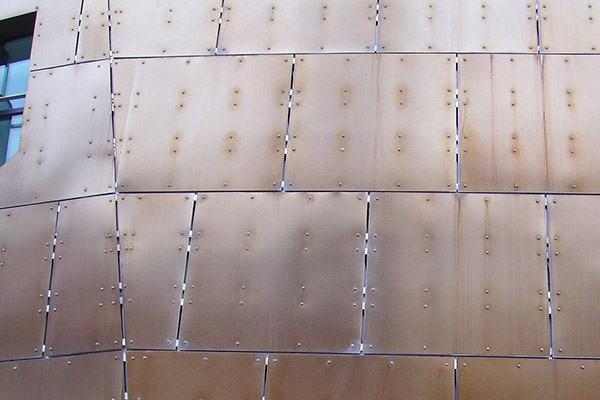How stainlesss steel sheet crops up in our daily lives.
From tomatoes…
The three clips of my braces, the sink where I wash the cap, the dishwasher, the wash machine, the fridge, the majority of the appliances in my kitchen, the lift, the bus I take to go to work, the roof and the cladding of the buildings around… the list could carry on forever!
We are surrounded, like it or not, by sheet metal.
There is one particular object which could symbolize the reasons why sheet metal is so diffused.
It is a very common object which shape and material hasn’t changed since the last 60 years and which also had its moment of artistic notoriety through the genius of Andy Warhol: the tomatoes tin can.

Campbell’s Soup Cans by Andy Warhol
As with many objects of common use it is almost impossible to find out who designed the first tomatoes can. Interestingly, it would be very difficult to modify, even slightly, in shape and material.
- It can be easily shaped as desired (malleable)
- It is light
- It is water tight
- It offers good structural performances
- It is relatively difficult to damage therefore it safely protects the content
The structural strength can be easily enhanced (the corrugation around the perimeter) It can be produced through industrial process - It can be treated to meet different requirement ( containing food in this case)
… to Buildings
The tomatoes tin can is made from a metal sheet (tinplate steel or aluminium usually), an element which can contain different type of metals, each with different properties. It is suitable for very different uses: from automotive industry through industrial design, food-related tools and appliances, aircraft construction, electronics, jewellery, architecture and many others.

Auto body component for passenger car created from sheet metal by Jobro, Sweden
In architecture, metal sheet can be used in a variety of ways but the use of the material for cladding systems is becoming more and more common and it offers many interesting possibilities to the designers.
A façade made with metal panels can in fact be designed as a completely free element not necessarily related to the rhythm of the structure behind it and it can be shaped, treated and coloured as desired.

Copper oxide-treated steel covering the dome of the Wales Millennium Centre designed by architect Jonathan Adams.
The metal panels used as architectural cladding offer many technical advantages from water resistance through to lightness and malleability. This explains why their use is quite established in practice and in the market.
As a designer I believe that it is fundamental to understand, beyond the nature of the material itself, the production process and the possibilities offered by the tools available in the industry. The production of metal panels is in continuous development and we (designers) can implement, improves, change the production chain and tools pushing the boundaries of what is currently feasible.
..through the forge
A quotation from Metals in Architecture by Paolo Portoghesi, Materia no 54)
“Vulcan, the god of war, is a smith, and in his forge he smelts and forms the metals that allows man to augment the effect of his physical strength through the hardness, lamination and relevant lightness of a material that can penetrate, cut, break down and destroy.”
Even though from Vulcan’s time to modern times the process of metal production has lost a bit of fascination it has gained a lot in quality and possibilities.
Industrial rolling
The introduction of the industrial rolling tools has made possible the production of rectangular sheets with controlled and continuous thickness for a theoretically unlimited length. Of course this has meant the giving up of the much more poetical blowing and hammering..
The principle of rolling is very simple: a rectangular thick plate of metal (the slab) is guided through a gap between two turning rollers; the gap is smaller than the thickness of the slab which is forced to become flatter. The process is then repeated few times and the slab goes through thinner gaps until the wanted thickness is achieved.
Hot rolling
The first rolling is usually “hot rolling”: the thick slab of metal is still red hot and goes through a gap to reduce its thickness from 150 mm to 12/20 mm and the result is a raw plate with a visible level of roughness on the surface. Afterwards the thickness can be further reduced with “cold rolling”: this process allows achieving much slimmer panels and smooth, consistent surfaces.
..toward stainless sheet
There is one material which personifies more than others that extreme combination of strength and lightness innate in metals which seduces overwhelmingly many architects and designers: that is stainless steel.
This material offers other qualities in addition to the many already quoted for the tin can: it has this appearance of a pure, basic metal, it almost represents the platonic idea of metal, but it is not affected ( or at least it is less affected) by a natural weakness of metals: corrosion.

Frank Gehry’s first skyscraper, the 76-storey New York with undulating stainless steel cladding. Photo by dbox
I would like to try and delve into the fascination for stainless steel and understand better what it is and why it is so beautiful… I’ll do my best with the next chapter.